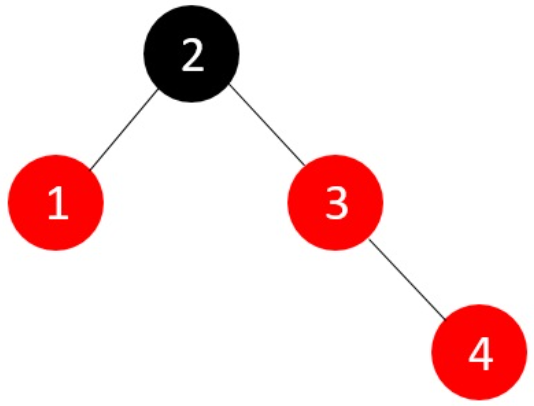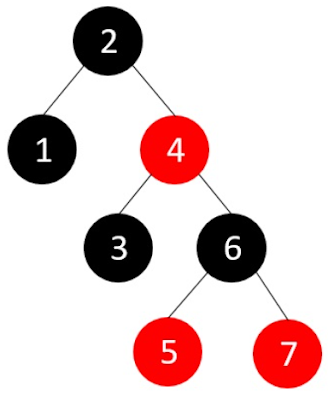Introduction to Red-Black
A
Red-Black Tree is a self-balancing binary search tree where each node has an
additional attribute: a color, which can be either red
or black. The primary objective of these trees is to maintain
balance during insertions and deletions, ensuring efficient data retrieval and
manipulation.
Red
Black Tree is a Binary Search Tree in which every node is colored either RED or
BLACK.
Every
Red Black Tree has the following properties.
Property #1: Red - Black
Tree must be a Binary Search Tree.
Property #2: The ROOT node
must be colored BLACK.
Property #3: The children
of Red colored node must be colored BLACK. (There should not be two consecutive
RED nodes).
Property #4: In all the
paths of the tree, there should be same number of BLACK colored nodes.
Property #5: Every new
node must be inserted with RED color.
Property #6: Every leaf
(e.i. NULL node) must be colored BLACK.
Node Color: Each node is
either red or black.
Root Property: The root of the
tree is always black.
Red Property: Red nodes cannot
have red children (no two consecutive red nodes on any path).
Black Property: Every path from a
node to its descendant null nodes (leaves) has the same number of black nodes.
Leaf Property: All leaves (NIL
nodes) are black.
Insertion into RED
BLACK Tree
In a Red-Black
Tree, every new node must be inserted with the color RED. The insertion
operation in Red Black Tree is similar to insertion operation in Binary Search
Tree. But it is inserted with a color property. After every insertion
operation, we need to check all the properties of Red-Black Tree. If all the
properties are satisfied then we go to next operation otherwise we perform the
following operation to make it Red Black Tree.
1. Recolor
2. Rotation
3. Rotation
followed by Recolor
The insertion
operation in Red Black tree is performed using the following steps...
Step 1 - Check whether tree
is Empty.
Step 2 - If tree is Empty
then insert the new Node as Root node with color Black and exit from the
operation.
Step 3 - If tree is not
Empty then insert the new Node as leaf node with color Red.
Step 4 - If the parent of
new Node is Black then exit from the operation.
Step 5 - If the parent of
new Node is Red then check the color of parent node's sibling of new Node.
Step 6 - If it is colored
Black or NULL then make suitable Rotation and Recolor it.
Step 7 - If it is colored
Red then perform Recolor. Repeat the same until tree becomes Red Black Tree.
Example:
Create a RED BLACK Tree by inserting the following sequence of numbers 8, 18, 5, 15, 17, 25, 40 & 80.
Sol:
insert (8): Tree is Empty. So insert newNode as Root node with black color.
insert (25) : Tree is not Empty. So insert newNode with red color.
insert (40) : Tree is not Empty. So insert newNode with red color.
insert (80) : Tree is not Empty. So insert newNode with red color.
finally, the above tree satisfies all the properties of the Red-Black Tree.
Example 2 :
Let
us construct an RB Tree for the first 7 integer numbers to understand the
insertion operation in detail
step 1:The tree is checked to be empty so the first node added is a root and is colored black.
Step 2: Now, the tree is not empty so we create a new node and add the next integer with color red,
The
nodes do not violate the binary search tree and RB tree properties, hence we
move ahead to add another node.
Step 3: The
tree is not empty; we create a new red node with the next integer to it. But
the parent of the new node is not a black colored node,
The
tree right now violates both the binary search tree and RB tree properties;
since parent's sibling is NULL, we apply a suitable rotation and recolor the
nodes.
Step 4:Now that the RB Tree property is restored, we add another node to the tree
The
tree once again violates the RB Tree balance property, so we check for the
parent's sibling node color, red in this case, so we just recolor the parent
and the sibling.
Step 5:We
next insert element 5, which makes the tree violate the RB Tree balance
property once again.
And
since the sibling is NULL, we apply suitable rotation and recolor.
Step 6: Now, we insert element 6, but the RB Tree property is violated and one of the insertion cases need to be applied
The
parent's sibling is red, so we recolor the parent, parent's sibling and the
grandparent nodes since the grandparent is not the root node.
Step 7: Now,
we add the last element, 7, but the parent node of this new node is red.
Since
the parent's sibling is NULL, we apply suitable rotations (RR rotation)
The
final RB Tree is achieved.


























No comments:
Post a Comment